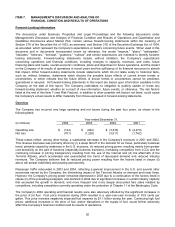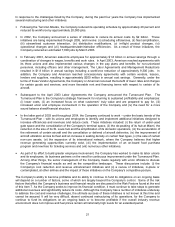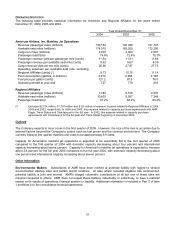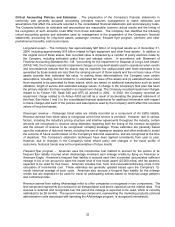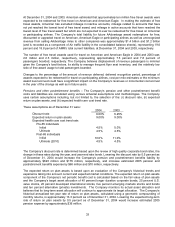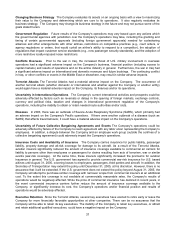American Airlines 2004 Annual Report Download - page 32
Download and view the complete annual report
Please find page 32 of the 2004 American Airlines annual report below. You can navigate through the pages in the report by either clicking on the pages listed below, or by using the keyword search tool below to find specific information within the annual report.
29
Effective January 1, 2005, in order to more accurately reflect the expected useful life of its aircraft, the Company
changed its estimate of the depreciable lives of certain American aircraft types from 25 to 30 years. The Company
expects this change in estimate to result in a decrease in annual depreciation expense of approximately $100
million in 2005.
2003 Compared to 2002 The Company’s operating expenses decreased 11.9 percent, or $2.5 billion, to $18.3
billion and American’s mainline operating expenses per ASM decreased 8.9 percent to 10.15 cents, including the
impact of special charges and the U.S. government grant. The decrease in operating expenses and operating
expenses per ASM is largely due to the Company’s cost savings initiatives coupled with security cost
reimbursements from the U.S. government and a decrease in special charges.
(in millions)
Operating Expenses
Year ended
December 31,
2003
Change
from 2002
Percentage
Change
Wages, salaries and benefits $ 7,264 $ (1,128) (13.4)% (a)
Aircraft fuel 2,772 210 8.2 (b)
Depreciation and amortization 1,377 11 0.8
Other rentals and landing fees 1,173 (25) (2.1)
Commissions, booking fees and credit
card expense 1,063 (100) (8.6) (c)
Maintenance, materials and repairs 860 (248) (22.4) (d)
Aircraft rentals 687 (153) (18.2) (e)
Food service 611 (87) (12.5) (f)
Other operating expenses 2,428 (287) (10.6) (g)
Special charges 407 (311) (43.3) (h)
U.S. government grant (358) (348) NM (i)
Total operating expenses $ 18,284 $ (2,466) (11.9)%
(a) Wages, salaries and benefits decreased due to lower wage rates and reduced headcount primarily as a
result of the Labor Agreements and Management Reductions, effective in the second quarter of 2003.
(b) Aircraft fuel expense increased due to a 15.1 percent increase in the Company’s price per gallon of fuel
(net of the impact of fuel hedging), somewhat offset by a 5.5 percent decrease in the Company’s fuel
consumption.
(c) Commissions, booking fees and credit card expense decreased due primarily to commission structure
changes implemented in March 2002.
(d) Maintenance, materials and repairs decreased due primarily to a decrease in airframe and engine
volumes at the Company's maintenance bases resulting from a variety of factors, including the retirement
and temporary grounding of aircraft and a decrease in the numbers of flights.
(e) Aircraft rentals decreased due primarily to the removal of leased aircraft from the fleet in prior periods as
part of the Company’s restructuring initiatives and concessionary agreements with certain lessors, which
reduced future lease payment amounts and resulted in the conversion of 30 operating leases to capital
leases.
(f) Food service decreased due primarily to a decrease in the number of departures and passengers boarded
and simplification of catering services.
(g) Other operating expenses decreased primarily due to decreases in (i) data processing expenses of $87
million due primarily to introducing further efficiencies into data processing environments resulting in
reduced consumption, and negotiating more favorable terms with vendors; (ii) travel and incidental costs
of $61 million due primarily to decreased overnight stays for pilots and flight attendants as a result of
changes in the scheduling of flights, lower average hotel rates, work rule changes and lower per diems;
(iii) insurance costs of $44 million due primarily to lower premiums, (iv) security costs of $31 million due
primarily to the assumption of certain security services by the Transportation Security Administration
(TSA) and the suspension of security services payments to the TSA from June 1, 2003 to September 30,
2003 and (v) contract maintenance work that American performs for other airlines of $29 million.



